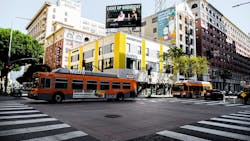OP-ED: How to pay for replacement of transit vehicles beyond their useful life
One justification for President Joe Biden's proposed transit investments in the proposed $2 trillion infrastructure plan is the need to replace 11 percent of buses, subway and commuter rail cars still in transit service beyond their useful life merits a more detailed discussion.
Every year, the Federal Transit Administration (FTA) provides billions under various formula and competitive discretionary grant funding opportunities to pay for over aged vehicles. The Federal Highway Administration has funding under several programs including Congestion Mitigation Air Quality (CMAQ), Surface Transportation Program (STP) and others, which can be flexed or transferred to FTA as a way to finance these replacement vehicles.
In the current federal fiscal year 2021, the FTA has made available $12.788 billion in funding under various formula and competitive discretionary programs. These dollars can be used, depending upon the program, to pay for replacement of over aged buses, paratransit vans, light rail, subway or commuter rail vehicles that are still in transit service beyond their minimum useful life federal replacement eligibility criteria. Some of these programs include Section 5307 Urbanized Area; $4.929 billion, Section 5307 Passenger Ferry $38 million; Section 5310 Enhanced Mobility of Seniors and Individuals with Disabilities $285 million, Section 5311 Rural Area Formula $644 million; Section 5337 State of Good Repair $2,723 billion; Section 5339 Buses and Bus Facilities Formula $2.709 billion; Section 5339 Buses and Bus Facilities Competitive $594 million (also includes Section 5339(c) Low or No Emission Competitive $180 million) and Section 5309 Capital Investment $2 billion. Here is a link to the FY21 apportionment tables.
There are also billions in carryover funding under these various formula and competitive grant programs still available. Check out fiscal year 2021 apportionment tables 14 - 17. For whatever reason, transit agencies have yet to enter or complete grants in the FTA's Transit Award Management System (TrAMS), which is used to award and manage federal grants.
In federal fiscal year 2022 and future years, similar if not greater amounts of funding under these various programs will become available.
FTA is very generous in programming these dollars. While working at FTA, I would encourage transit agencies to utilize pre-award authority. This permitted any recipient of FTA funding the opportunity to incur costs prior to grant approval. Including option clauses would also be offered. This afforded agencies to award a base bid, plus up to five years of options after the contract award date. In future years, utilization of this option would speed up delivery of replacement vehicles. Should bids come in below the amount of available funding in obligated grants, recipients can increase quantities ordered.
Any transit agency, based upon FTA criteria of mileage or age, can plan in advance when overage vehicles can be replaced. The average procurement process takes up to one year. This is based upon development of bid specifications, advertisement, response to bidders questions, award and notice to proceed. Actual delivery of replacement buses averages one to two years. This is dependent upon the type of vehicle and backlog of orders faced by the winning vendor. Subway or commuter rail cars take four to five years. In many cases, we would approve funding for replacement of vehicles, documented by interim project milestones contained with grants, several years in advance. It is easy to work with the FTA Regional Office to be sure that vehicles being replaced remain in transit service until such time they reach eligibility based an criteria. All of the above offers transit agencies greater flexibility in replacement of overage vehicles quickly and efficiently, while still remaining in compliance with FTA rules and regulations.
FTA Region 2 (serving New York and New Jersey), the New York and New Jersey State Departments of Transportation maintain the Statewide Transportation Improvement Program (STIP). Each Metropolitan Planning Organization (MPO) for every urbanized area affiliated with NYSDOT and NJDOT maintains a local Transportation Improvement Program (TIP). This includes the New York Metropolitan Transportation Council (NYMTC). It is comprised of the New York City, Long Island (Nassau & Suffolk County) and Mid Hudson South (Westchester, Putnam & Rockland County) Transportation Coordinating Committees. Both the STIP and TIP documents contain a complete inventory of potential transportation improvement projects, such as vehicle replacements, respective sponsoring agency, estimated cost and funding source. The current TIP/STIP should have a fully programmed Annual Element (2021), Bi-Annual Element (2022) along with years 2023, 2024 and 2025 list of capital projects including funding sources. All MPOs, NYS DOT and NJDOT maintain five year short range and 20 year long range plans. They include lists of potential capital transportation improvement projects by recipient and operating agency. A careful detailed review of all of these documents is necessary to validate the New York Metropolitan Transportation Authority, New Jersey Transit and more than 30 other designated recipients of FTA funding for their share of the proposed $39 billion.
Every transit agency maintains up-to-date bus, paratransit, ferry, light rail, subway or commuter rail fleet management plans. These documents also need to be reviewed. This analysis could help determine what the financial shortfall is, transit agency by transit agency for replacement of overage equipment. Have these documents been updated in 2021? Many transit agencies will not see a return to 80 percent or 90 percent of pre COVID-19 ridership until 2024 or 2025.
Anticipated ridership growth based upon expansion of existing or new system projects pre-COVID-19 numbers also need to be reevaluated. How many former commuters will continue to work from home full or part time? How does all this impact ongoing and future bus, paratransit, ferry, subway, light rail and commuter rail equipment purchases for routine replacement versus system or service expansion? Are any of these projects being counted as part of "canceled or delayed" capital projects due to financial shortfalls?
How many of the 11 percent of vehicles which need to be replaced already have local, state, transit agency or previously approved FTA formula or competitive discretionary grant funding? How many of these vehicles have FTA formula or competitive discretionary allocated or authorized funding but not yet applied for? Have draft grants been entered into TRAMs? How many of these vehicles are already on order by a local, state, transit agency or FTA-funded vehicle procurement?
Finally, how many transit agencies have procurements already awarded which include option clauses? FTA allows option clauses for up to five years after any contract award date. Use of an option clause can result in an earlier delivery for replacement vehicles at a better price. Sometimes the manufacturer can add option vehicles to the base bid assembly production line slot. It also saves any transit agency the cost of initiating a new vehicle replacement procurement from scratch. Having more vehicles from the same model can save on the overall fleet maintenance costs. Fewer different equipment models can translate to the need for fewer different spare parts.
My old colleagues at the FTA's 10 Regional and HQ offices need to conduct their own independent analysis for all of the above to confirm justification for how much real new additional funding is needed to replace the 11 percent.
FTA may also need the assistance of Financial Management Oversight (FMO) Consultants to assist Regional and HQ Office staff in conducting this exercise. Transit riders, taxpayers, transit advocates and elected officials at all levels of government deserve accuracy and transparency to justify any additional funding. Washington faces a $29-trillion long term national debt. It will grow by trillions more in coming years. Every dollar must be accounted.
-----------------------
Larry Penner is a transportation advocate, historian and writer who previously worked for the Federal Transit Administration Region 2 NY Office. This included the development, review, approval and oversight for billions of dollars in grants which provided funding for capital projects and programs to the NY MTA, NYC Transit, Long Island and Metro North Rail Roads, MTA Bus, NYC DOT, NJ Transit and more than 30 transit agencies in New York and New Jersey.

Larry Penner
Larry Penner is a transportation advocate, historian and writer who previously served as a former director for the Federal Transit Administration Region 2 New York Office of Operations and Program Management. This included the development, review, approval and oversight for billions in capital projects and programs for New Jersey Transit, New York Metropolitan Transportation Authority, NYC Transit bus, subway and Staten Island Railway, Long Island and Metro North railroads, MTA Bus, NYCDOT Staten Island Ferry along with 30 other transit agencies in New York and New Jersey.



